We kindly inform you that, as long as the subject affiliation of our 300.000+ articles is in progress, you might get unsufficient or no results on your third level or second level search. In this case, please broaden your search criteria.
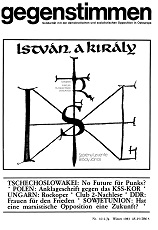
Der Gegenwart mit der Vergangenheit beizukommen, ist ein für Ungarns Musikschaffende bereits bestens erprobtes Stilmittel: Die Nationaloper »Banus Bank« von Ferenc Erkel — in der zweiten Hälfte des 19. Jahrhunderts, nach der Niederwerfung der bürgerlich-demokratischen Revolution 1848 geschrieben — enthielt ebenso flammende Appelle der nationalen Unabhängigkeit, wie es Verdi etwas früher verstanden hatte, den Gedanken des nationalen »Risorgimento« der Italiener musikalisch zu fasjsen.
More...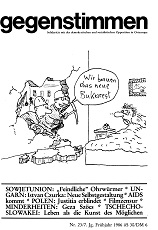
Die Kammerjäger im Auftrag des ZK und des Ministeriums für Kultur standen diesmal vor einer besonders schwierigen Aufgabe: An den wachsamen Augen und Ohren der Hüter des sozialistischen Plakatrealismus vorbei hatte sich allerlei künstlerisch schwaches Ungeziefer in die ideologisch nicht gefestigten Köpfe der sowjetischen jungen Generation geschlichen. Dort schwirrten sie und surrten sie herum, gesteuert von den elektromagnetischen Impulsen ihrer Absender, den Brutstätten minderwertiger Musik und provokant-schnoddriger Kommentare über die Wünsche und Gefühle der dekadenten young generation of the western and eastern world. „Hallo, molodzy“, meldet sich Abend für Abend eine propagandistisch- angeheizte Stimme aus dem westlichen Äther, die aus dem Roman Clockwork Orange des sozialkritischen Autors Burrough gesprungen sein könnte.
More...
The study „Sergei Cretu and neo-traditional music: the creative path in the Soviet period” sketches a brief portrait of the artist, highlighting the important biographical data on specialized studies, the context of professional evolution in the Soviet period of the 1960s-1980s, marked by the so-called „new wave of folklore”. Special emphasis is placed on the refl ection of his activity as a dulcimer player, arranger and composer in the Popular Stage Orchestra and in the „Folclor” Orchestra of the Moldovan Republican Television and Radio Broadcasting Company. Th e main compartments and aesthetic directions in the his interpretive and compositional creation, the structure of the genres and styles, including the place, the sources and the social motivations of the works of Soviet ideological inspiration and instrumentalization are also highlighted. Th e study capitalizes on documents, data and information from the Archive of the „Teleradio-Moldova” Company, materials from the press of the time, audio and video sources as well as a series of concepts from modern specialty literature, able to promote the interpretation and analysis of cultural facts.
More...
If the 18th century initiated - through Psaltichia Rumănească by Filotei sin Agăi Jipei - the process of autochthonization of psalter singing in the Romanian area, and then it ensured its upward course, the first half of the 19th century marks the zenith of the approach, bringing in the foreground personalities such as Macarie Hieromonk and Anton Pann. Both the Macarian concept of Romanization of sacred singing, as well as Anton Pann’s achievements in this domain, have a certain artistic and instructive value and, in their time, were affirmed as attitudes and models to follow. At the same time, the current Byzantinistics insists on the limited character of these contributions, showing that the two precursors only referred to Constantinopolitan singing after 1814 and did not capitalize on the old autochthonous liturgical music, did not take into account the psalter singing from villages, close to the folkloric matrix. They aimed especially at the text of the pew singing and not at the musical background, which changes only to a small extent.
More...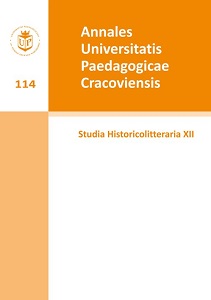
The author traces the influences of the Battle of Grunwald, 1410 (understood as a cultural artifact) in various works of art. The religious hymn Bogurodzica (Mother of God), known already before the Battle, after 1410 gained the status of national anthem, promoted by the chronicler’s account of the event. The Battle of Grunwald features in Polish literature, painting, music, film and even in the latest tools for communication and education (board games, the Internet). The article serves as an introductory sketch to the complex issue of the significance of the mythologised Polish victory in the development of Polish artistic culture.
More...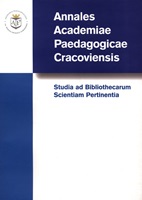
The article is one more study within the series presenting the cultural life of the Polish emigration, in the broadest sense of the word, during World War II, as written about in the London "Dziennik Polski in 1940-1943, i.e. before merging with "Dziennik Żołnierza". It analyses the music and the theatre. It argues that the Poles-artists, everyone of them, to the best of their abilities, got actively involved in the struggle to maintain the vitality of the Polish cause on the international arena during the discussed period. They accomplished that through organizing regular concerts and recitals in Great Britain, the United States, in the Middle East, or in Africa; promoting the Polish music by Fryderyk Chopin, Ignacy Paderewski (including his patriotic political activity) and Stanisław Moniuszko; presenting the profiles of the contemporary Polish composers living abroad, as for example Henryk Opieński; organizing fundraisers for the Polish prisoners of war; organizing theatre and ballet performances. Glorification of the national composers and performers was also meant to augment the national pride, and to build the sense of national community in the traumatic time of war.
More...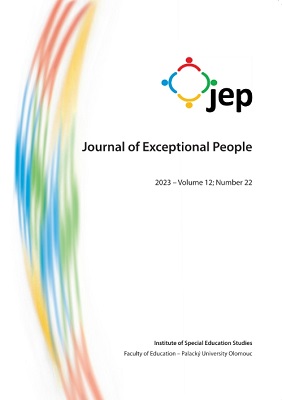
Review of: -Phil Jones, The Arts Therapies: A Revolution in Healthcare | Polly Bowler, Rachael Hood, Eleanor Keiller, Helen O’Loughlin, Katherine Rothman | 2022, Book review | First published online February 15, 2022
More...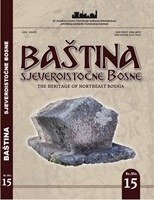
In the period between the two world wars, there were no musical groups in northeastern Bosnia schools. In Bosnia and Herzegovina, since 1920, the only regional music group has been active in Sarajevo school. The most significant activity in musical life in this period was performed by performers ensembles. Mostly, these were choirs that worked for singing societies and others instrumental orchestras and ensembles. For the reasons mentioned, there was a need for research, by collecting, revealing and analyzing data, with the basic goal of seeing the facts about activities of singing societies in this period and their contribution to the development of musical culture.
More...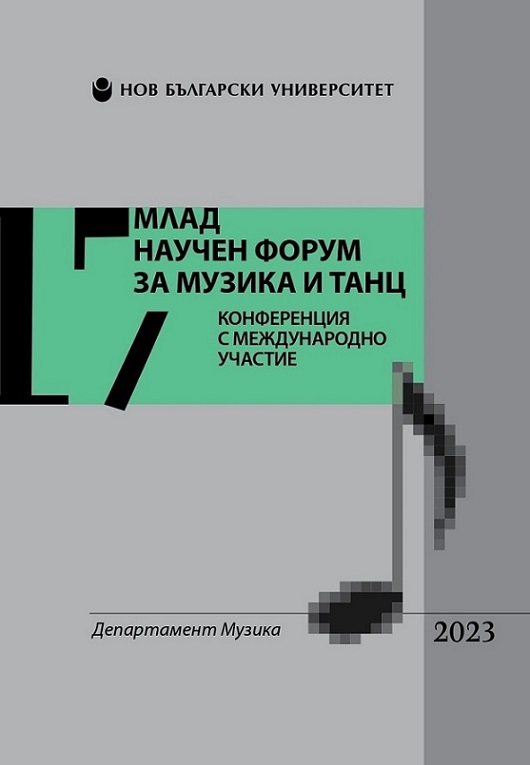
The study was carried out in the period 2017-2022 among the first-year students attending the Aerobics discipline at New Bulgarian University (NBU). A quantitative evaluation (based on visual measurements) was carried out by the teacher during the classes according to the following criteria: changes in the quality (purity) of the performed exercises, changes in the volume of repetitions, changes in motivation in different musical schemes where the tempo is decisive. The main arguments for the selection of musical themes for cardio training in physical education classes at NBU are: selection of a playlist with an optimal overall tempo for the whole class (moderate – medium moderate – fast – medium moderate – slow), emphasis on more melodic songs; selection of current hits with a preference for the „Latin“ style, selection of songs and melodies with a strong associative context, i.e. works related to the personal experience of the participant.
More...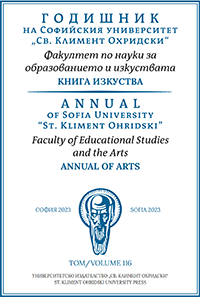
The article considers, for research purposes, the role and the meaning of the lyrics (words) in the vocal-instrumental genres of the English-speaking world, emphasizing its content and meaning. A counterpoint to this type of musical genre is instrumental music, which in specific cases is used as an opportunity to compare different musical forms. Special attention is paid to the sung words in the musical works of the English-speaking world in the context of the distinction between speech and language.
More...
The article seeks to establish a foundational framework for comprehending crucial definitions and concepts related to auditory space in digital gaming, particularly focusing on audio games designed for visually impaired individuals (VI), often devoid of graphical interfaces. While existing studies often emphasize players’ interactions with interfaces and the acquisition of real-life skills, this text explores audio games through the lens of entertainment and immersion. Numerous studies indicate a demand among visually impaired players for more intricate and challenging games, incorporating elements usually used in standard digital gaming experiences. By combining definitions from both audio and traditional digital games, this article broadens the scope of sound design considerations, encompassing various aspects and classifications. It presents several auditory dimensions, consolidating them into a comprehensive dimension called attenuation, putting their roles within a game’s context. The author is a sound designer currently working on an audio game; therefore, many of the presented definitions are also a guide that will represent some of his own considerations while working on this game. These include not only the use of binaural or ambisonic sound but also understanding the ways and means of how to work with (3D) space in the context of audio and its possible functions.
More...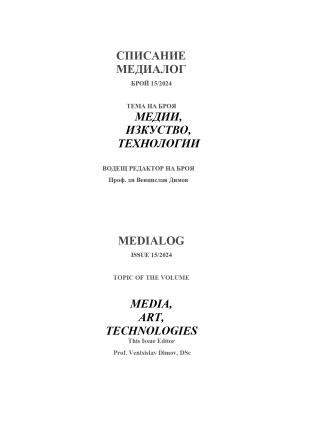
The Hezhe people (Nanai people) are a minority ethnic group with a long history in Northeast China, who are good at singing and dancing. Their music mainly records their life and daily production, especially their fishing traditions. The article analyzes the song "Mountains and Rivers Bewitched the Nanai people", exploring the musical culture and expressions of the Nanai people and focusing on the musical structure, melody, rhythm, force, tempo and structure of the accompaniment. The role of the emotions that the song evokes is also discussed. The purpose of the article is to expand the interest in Nanai folk music, familiarization with it for the further study and even better performance of Nanai music and songs.
More...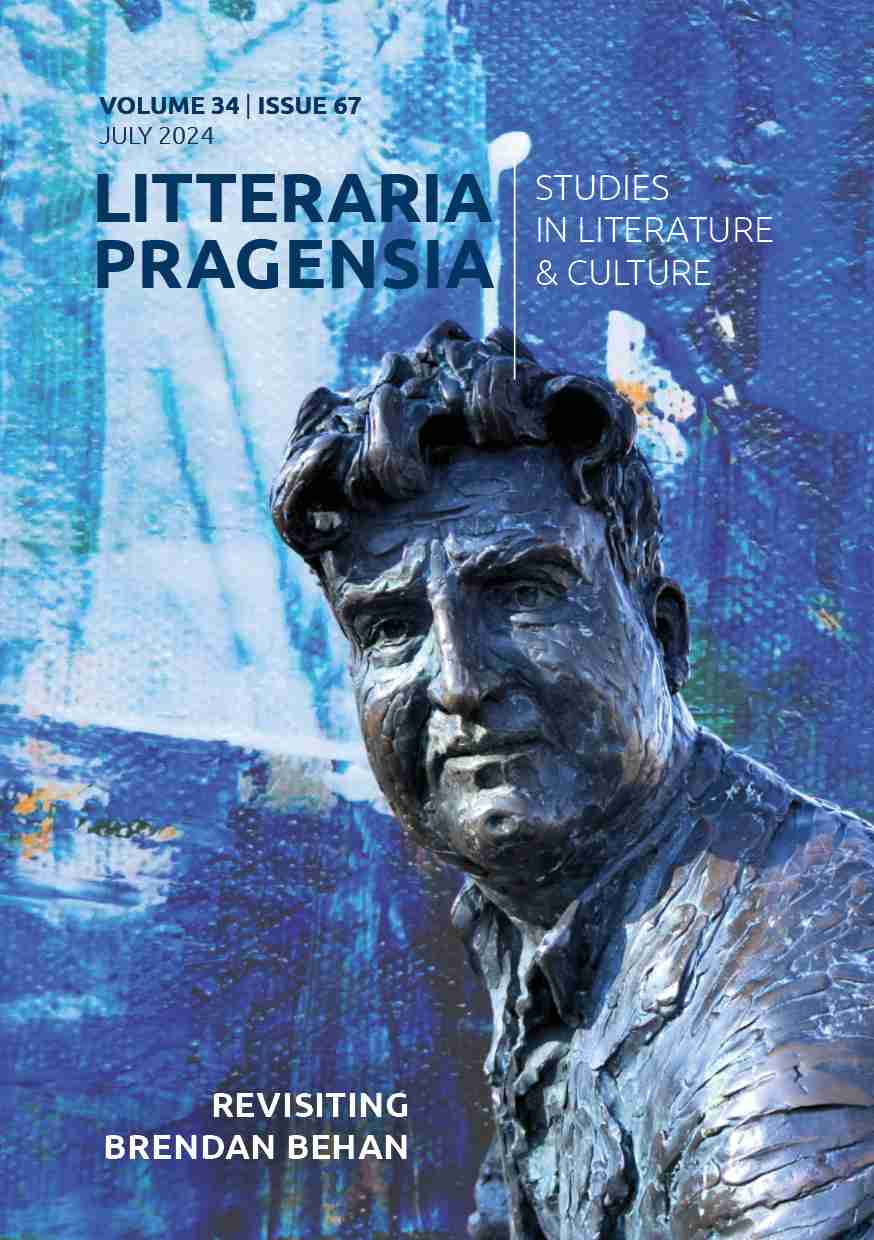
Although most well-known for his plays and prose, the Irish writer Brendan Behan also recorded a number of songs, some of his own composition and others either traditional or written by contemporaries. His best-known recording, Brendan Behan Sings Irish Folk Songs and Ballads, remarkably captures not only his voice, but also his wit and distinct joie de vivre. The collection from 1960 includes not only the songs themselves (with Behan still in fine singing form), but also his introductions and wry comments on a range of subjects. The article looks at the circumstances behind the recording, the actual songs included on the album, and Behan’s ongoing commentary about a range of topics. The focus is on the first half of the recording which consists of songs from his play The Hostage, with an additional short discussion of one of his most well-known pieces, “The Auld Triangle,” which serves as an ongoing leitmotif in his earlier play, The Quare Fellow.
More...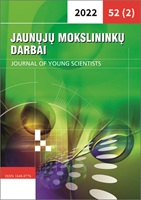
The article reviews the ideology of the É. Jaques-Dalkroze musical-rhythmic education system, the eurythmy method is described, as well as its practical significance in developing a sense of rhythm through a case study, in the 7th grade music lessons of X Pro-Gymnasium.The results of the qualitative activity study revealed that students with good coordination, reaction, and motor skills have a good sense of rhythm. The sense of rhythm of weakly sensitive/anti-arrhythmic research participants during the practice of eurythmy exercises developed positively: the reaction of the participants improved, the internal sense of time duration, body movements became more expressive during the rhythm, and anti-rhythmicity no longer appeared during the practice of eurythmy exercises. Also, after practicing eurythmy exercises, better social skills, emotional state, and positive classroom climate of the participants were observed.
More...
Music education, which complements formal education, is, in the essence of the realization of its educational process, close to the essence of the self-directed learning process, therefore there are theoretical and practical possibilities for the realization of self-directed learning in a music school. The application of self-directed learning redistributes the power and responsibilities of the participants of the educational process, therefore opportune preconditions are created for the change of the interaction between the pupil and the educator and for the transition from teaching to learning. Therefore, the provision is observed that the implementation of self-directed learning in educational practice changes the quality of the educational process. The article analyzes how the self-directed learning, established in the educational process of a specific music education institution (music school) that complements formal education changes the interaction between the pupil and the educator, what circumstances are significant, what are the links with the quality of the educational process. The analysis of the results of the empirical research allows us to state that teachers understand self-directed learning and its importance theoretically, but teaching itself has not become a natural strategy for organizing the educational process; fragmentary features of pupils’ self-direction are seen, positions of learning power are more characteristic of teachers than pupils.
More...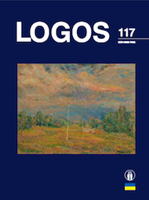
The article presents a study of piano work by Iannis Xenakis in connection with the peculiarities of the composer’s personality. A comparison is made between Martin Heidegger's philosophy and the writings of Iannis Xenakis. Biographical paradigms of I. Xenakis’s compositions with the focus on his opuses for piano accompanied by a symphony orchestra, are studied. The primary themes of the composer's work including antiquity, alienation, loss of mother, experience of a trauma are established. The philosophical aspects of the compositions Eonta, Synaphaï, Erikhthon, and Kegrops are compared with the concepts of Heidegger's Being and Time. The issue of “being thrown into being” mentioned by M. Heidegger is investigated in I. Xenakis’ Concert Erikhthon. It is concluded that I. Xenakis and M. Heidegger share common views on the unity of the ancient Greek philosophical foundation and its relation to the modern world.
More...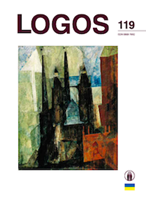
Drawing on the example of the “Golden Snail Opera”, the article discusses the essential aspects of the cultural, scientific and political impact of contemporary art, which is rising ecological awareness and appealing to the understanding of the challenges of the Anthropocene. By transcending the distinction between nature and culture through works of art or artistic political events, the prevailing idea of the aesthetic relationship with the work of art and the theoretization based on it are becoming meaningless. The primary is an artistic exploratory political process involving the wider community. The group of 4 women artists and scientists who created the "Golden Snail Opera" is an example of the unbreakable globalization of East and West, as well as the cultures and scientific institutions of the global South and North. In the video of 7 actions with a prologue and an epilogue, there are three characters, whose texts can be read by one or three voices, and the connection of the work is performed on Taiwanese drums. The work was created by filming and recording the specific experience of a particular farming in the cultivation of rice in an area of Taiwan, it collected and summarized large-scale, diverse scientific data that showed how lifestyles and people's self-awareness changed in this area, how modern capitalism "broke" traditions, how people were forced to adapt to new living conditions, which increasingly began to be associated with the events of globalization and their consequences. The main character of the opera is a golden snail appearing in its own sounds and images, brought from Argentina and became a harmful invasive species with which humans began to learn to coexist. The article also uses other works of ecological scientific artistic research that develop a "more than human" attitude towards the world or an "ontological turn", and highlights the aspect of the world's multispecies consciousness and spirituality that emerges in these arts. In this aspect the experience of the life of mankind is accumulated.
More...
Review of: Радмила Стојановић, Озренка Бјелобрк Бабић (2023): Универзитетски уџбеник вокално-инструменталне наставе/музике. Бања Лука: Филозофски факултет Универзитета у Бањој Луци и Арт Сцена д. о. о., стр. 194.
More...
The paper deals with the analysis of using the Motherland symbol by the Soviet popular songs in order to represent the Cold War issues. Using quantitative and qualitative content analysis, the authors examine more than 1500 Soviet songs (1946-1991); 350 of them employ this symbol. The article demonstrates that the -Soviet Motherland served as one of the most significant components of the -cultural Cold War. The meanings of the symbol reflected the basic traits of the USSR-U.S. confrontation. In its own turn, exploiting this symbol introduced additional characteristics to the Cold War, representing it as not only ideological conflict but also as national by nature. The authors also point out that the cult of the Motherland had an influence on the perceived value of maternity in the USSR, contributing to the fact that mother serves as ideal Soviet woman.
More...